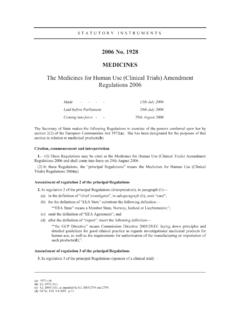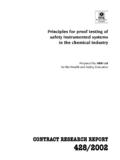Transcription of INFORMATION FOR THE PROCUREMENT AND …
1 INFORMATION FOR THE PROCUREMENT AND CONDUCT OF NDT Part 4: Ultrasonic Sizing Errors and Their Implication for Defect Assessment April 2008 Page 1 of 32 Executive Summary Once defects have been detected in a component, ultrasonic inspection is frequently used to provide INFORMATION about them to permit an assessment of whether the component is fit for continued service. data on the size and position of the defects is used in an assessment of structural integrity for this purpose. The methods used for ultrasonic size and position measurement and the data to be recorded following the inspection must be specified in the ultrasonic procedure. Responsibility for the adequacy of the procedure is with a Level 3 ultrasonic practitioner.
2 The Level 3 practitioner is also responsible for assessing the errors involved and this document provides INFORMATION on methods of error assessment. Responsibility for use of the ultrasonic data and its associated errors in structural integrity assessment is with a Structural Integrity Engineer. In particular, the decision on the maximum defect size to be used in the calculations how many standard deviations should be added to the reported values, must be made by the Structural Integrity Engineer. This should be done in a way which ensures that the level of confidence in the ultrasonic sizes used in the calculations is commensurate with the confidence level in the other data used in the process. Both ultrasonic error assessment and structural integrity analysis can be carried out in a number of ways.
3 Simple methods can be used which provide conservative results. More sophisticated methods of assessment can be used to reduce the conservatisms of the simplified approaches. There is also the possibility of using advanced ultrasonic sizing methods with lower intrinsic errors. If simple methods show that the component is safe to operate in spite of the inherent conservatisms in the methods of calculation, nothing further may be necessary. If, however, the simple methods do not provide a case for continued operation, the more sophisticated measures for error assessment and structural integrity assessment may be able to make the case but usually at the cost of increased time and complexity. What is appropriate in a particular situation must be judged taking into account the significance of the component and the consequences of its failure.
4 This document provides INFORMATION on how to make such judgements. Three case studies are given to illustrate the use and benefits of increasingly sophisticated methods of integrity and error assessment. Page 2 of 32 1. Introduction The Health and Safety Executive (HSE) have been promoting improvements in the reliability of all methods of NDT through the PANI projects [Refs. 1 & 2] and associated best practice documents [Refs. 3, 4 & 5]. Whilst the PANI projects have been primarily concerned with ultrasonic defect detection, sizing data has also been collected and analysed. In PANI 1, the through wall sizing results obtained from the 25 mm thick double V butt weld test piece varied between 2 mm and 10 mm for an 8 mm crack at the weld root and between 2 mm and 10 mm for a 3 mm LOSWF defect.
5 PANI 2 data shows a similar spread of results as illustrated in Figure Actual TWE versus Measured TWE for the control groupy = + (mm)Measured (mm)ControlLinear (Control) Figure Example of the Scatter in Through Wall Sizing Results Obtained in PANI 2 Note: The through wall extent (TWE) of the defect is defined as the perpendicular height of the defect relative to the scanning surface. The illustration, by the PANI projects and other sources, of the potential errors in ultrasonic sizing, as outlined above, raised HSE s concerns regarding such errors and how they are considered in defect assessment (Engineering Critical Assessment ECA). Following the successful production of the HSE documents describing best practice for the PROCUREMENT and application of manual ultrasonics [Ref.]
6 3], magnetic particle and dye penetrant inspection [Ref. 4] and radiography [ ] and in the light of the above concerns, the HSE have judged it appropriate to issue the present document Page 3 of 32 with a view to promoting the adoption of good practice whenever ultrasonic defect sizing data is used as an input to defect assessment. This document is oriented towards the inspection of welds because these are a very common location for defects and hence the subject for defect assessment. However, the principles it contains are equally applicable to all component types. The document does not address the errors associated with ultrasonic wall thickness measurements. The INFORMATION applies both to inspections and defect assessments carried out by departments of the company owning or manufacturing the plant and to those carried out by external NDT and defect assessment organisations under contract.
7 In the latter cases, it is intended to assist in the PROCUREMENT process by highlighting the issues that need consideration. In addition, the INFORMATION draws attention to the need to seek appropriate advice when undertaking any detailed review of the ultrasonic errors or the defect assessment activities. The INFORMATION contained in this document is recommended by the HSE for the conduct of defect assessment in industry. The document provides INFORMATION on how to address the errors inherent in ultrasonic sizing and on how these impact on the defect assessment process. It is intended to raise awareness of the issues and to give INFORMATION on how an appropriate ultrasonic inspection and defect assessment process can be applied.
8 This document is not intended to replace the relevant technical standards or to supersede them in any way. The document is primarily concerned with ultrasonic inspection as this is the main NDT method for establishing the through wall size of defects for input to the defect assessment process. Other NDT methods, such as MPI and dye penetrant, may be used to provide additional INFORMATION on the length of a surface-breaking defect but these are not covered here. The document has been drawn up by a committee comprising both NDT and structural integrity experts assembled by the HSE for this purpose. Their names and affiliations are given in Appendix 1, from which it will be apparent that they represent a wide range of those parts of British industry using defect assessment based on ultrasonic sizing.
9 In addition, they have considerable expertise in and responsibility for the application of NDT to industrial plant and the assessment of the plant using the results of NDT. The recommendations contained in this document are based on two main sources in addition to the PANI data . The first is a literature search and subsequent review of relevant published papers, international standards and articles regarding ultrasonic sizing errors and defect assessment. The second basis for the recommendations is the collective experience and expertise of the committee mentioned earlier. The members representing the NDT community were also members of the PANI Management Committee [Refs. 1 & 2] and the committees responsible for the previous best practice documents [Refs 3, 4 & 5].
10 Section 2 describes the data and personnel competencies which are necessary pre-requisites for the sizing and defect assessment process once a defect has been detected. It also describes the responsibilities which the different personnel must assume. Section 3 identifies recommended measures to be applied in determining ultrasonic sizing errors and accounting for them in defect assessments. It is recognised that the extent to which it is reasonable to expend extra effort on the Page 4 of 32 inspection or defect assessment, and incur additional costs as a result, depends on the role of these activities in assuring plant safety, the economics of the activities and the consequences of the activities failing to achieve their objectives.











